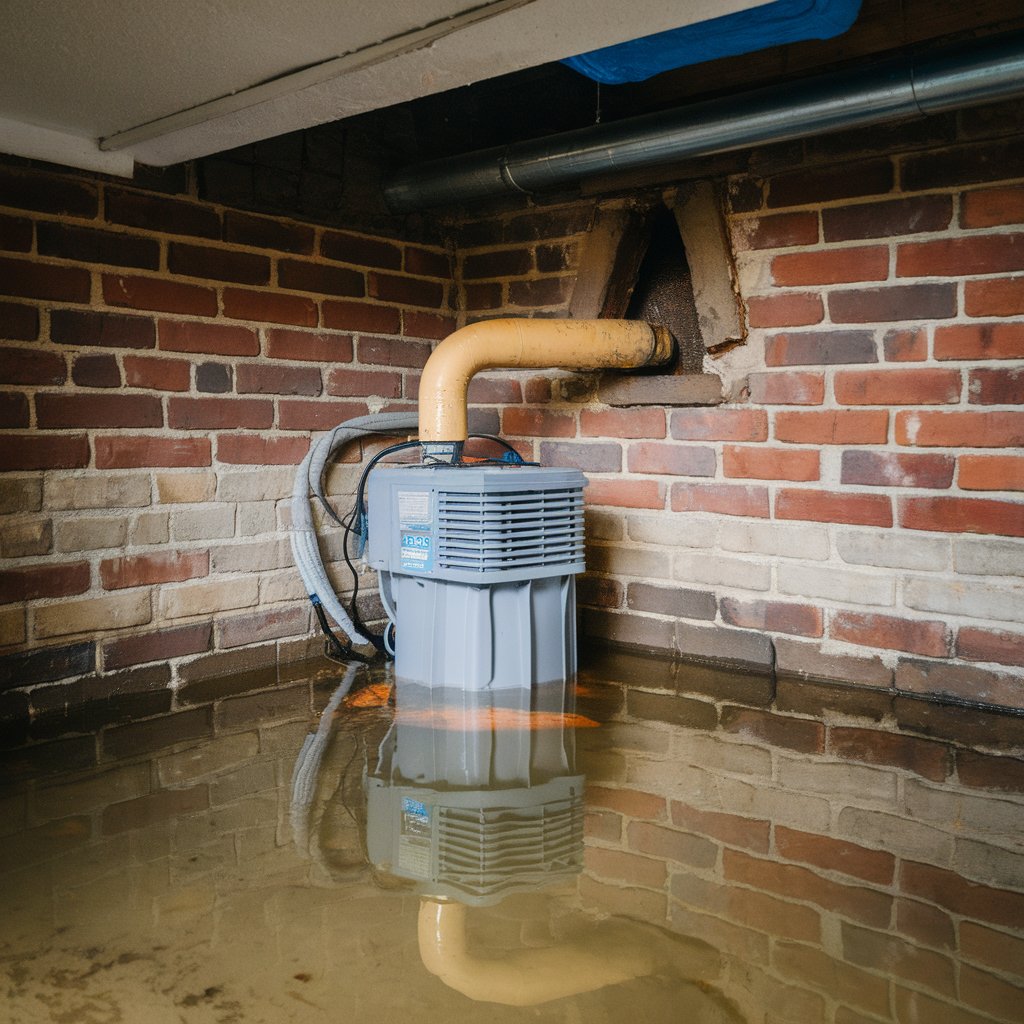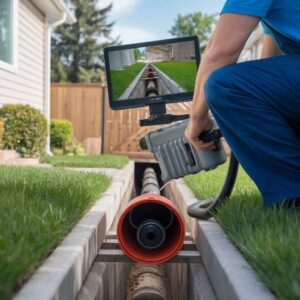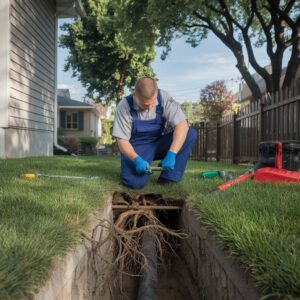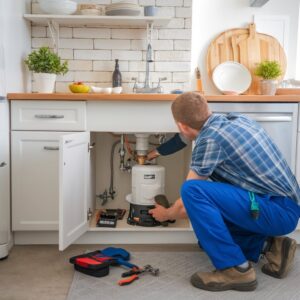A sump pump is installed in a sump pit to manage and remove groundwater, protect against basement flooding, and relieve water pressure around a home’s foundation. It features an automatic activation system, utilizing float or electronic switches to detect water levels. Once active, it efficiently directs water through a discharge line, ensuring structural integrity. With various pump and switch types, homeowners can explore customized solutions and maintenance requirements for ideal water management performance. Further details illuminate these essentials.
Key Takeaways
- To prevent basement flooding, a sump pump removes excess groundwater from a sump basin.
- It activates automatically when water levels rise, using switches like float, diaphragm, or electronic.
- The pump expels water through a discharge line, directing it away from the home’s foundation.
- Effective operation and structural safety depend on proper sump pump installation and consistent maintenance.
- Battery backups ensure operation during power outages, maintaining flood prevention.
What Is a Sump Pump and Why Might You Need a Sump Pump in Your Home?
A sump pump is an essential hydraulic apparatus designed to efficiently evacuate excess groundwater from a sump basin, reducing water pressure around the foundation and lowering the risk of basement flooding.
Equipped with a high-efficiency impeller and a reliable float switch mechanism, a good sump pump rapidly redirects water away from the home foundation, ensuring structural integrity and preventing costly water damage.
Homeowners residing in flood-prone or high water table regions should consider integrating a sump pump system as a preemptive flood control measure to safeguard their property against inundation events.
What Does a Good Sump Pump Do to Prevent Water Damage?
Many homeowners need an effective sump pump to mitigate water intrusion and prevent potential damage. A good sump pump, whether submersible or pedestal, is a vital defense against water damage by efficiently evacuating water from the sump pit.
The pump capacity, essential for handling significant water volumes, should match the specific requirements of the affected area. Integral components like the float switch activate the pump when water levels rise. A reliable discharge line guarantees proper expulsion of water away from the foundation.
Battery backup systems offer redundancy, maintaining operation during power outages. Install a sump pump to guarantee peak functionality, safeguard residential structures against potential inundation, and maintain structural integrity.
Why Should Homeowners Consider a Sump Pump for Flood Protection?
Homeowners seeking robust flood protection mechanisms must consider the installation of a sump pump. This essential component of a thorough drainage system is a key line of defense against rising water levels and a fluctuating water table.
A well-engineered sump pump system efficiently channels excess water away from a home’s foundation, preventing potential structural damage. Sump pump installation is essential in areas prone to heavy rainfall or flooding, where water intrusion is a significant risk.
Incorporating a backup pump is critical to mitigate pump failure, ensuring continuous operation during power outages. This redundancy fortifies flood protection measures, maintaining operational integrity.
Consequently, a sump pump safeguards property and augments resilience against unpredictable heavy rain events.

How Does a Sump Pump Work During Heavy Rain?
During periods of heavy precipitation, sump pump efficacy is critically influenced by the type of switch mechanism employed, whether tethered, vertical, or electronic.
Each switch type governs activation thresholds and response times, impacting the pump’s ability to manage voluminous water influx effectively.
The sump pump discharge system, equipped with check valves and freeze-resistant piping, is pivotal in mitigating hydraulic overload and safeguarding structural integrity against potential water damage.
How Do the Different Types of Sump Pump Switches Affect Performance?
How essential is the role of sump pump switches in determining overall system performance during heavy rainfall? The sump pump is a device that relies heavily on its switch to trigger the pump to turn on and function efficiently, ensuring that water in the basement is removed promptly.
Various sump pump switches influence how a pump works, affecting submersible and pedestal sump pump models.
- Float Switch: This common switch type activates when water in the pit rises, which is typically at the lowest point in your basement, vital for the sump pump to work promptly.
- Diaphragm Switch: Sensitive to water pressure, it guarantees the pump is running when water levels rise, reducing sump pump failure risks.
- Electronic Switch: Utilizes sensors to detect water presence, offering precision in pump activation, essential during heavy downpours.
Each switch type’s effectiveness is pivotal for mitigating water ingress and guaranteeing operational integrity, keeping your basement dry and your sump pump functioning optimally.
How Does the Sump Pump Discharge System Protect Against Water Damage?
When evaluating the functionality of a sump pump discharge system during heavy rainfall, it is critical to contemplate the system’s capacity to efficiently redirect accumulated water from your basement away from the foundation.
The sump pump is installed in a sump pit, designed to move water into the pit and then pump it out, ensuring that the pump is activated when needed and that the sump pump works efficiently. This mechanism helps your basement stay dry by directing water away from the structure’s base, serving as a primary line of defense against water infiltration, reducing water pressure, and preventing potential structural damage.
What are the Main types of Sump Pump Options for Homeowners?
Homeowners selecting sump pump systems must consider submersible and pedestal variants, each exhibiting distinct operational efficiencies and limitations.
Submersible pumps, while offering superior noise reduction and cooling capabilities due to their submerged design, may suffer from reduced longevity compared to pedestal models, which provide easier access for maintenance but at the cost of increased noise levels.
Integrating a battery backup system is critical for mitigating power outage risks and ensuring uninterrupted sump pump functionality during critical high-water events.
What Are the Pros and Cons of Installed Sump Pumps?
Although advantageous in mitigating basement flooding, installed sump pumps present a spectrum of pros and cons that merit consideration. The purpose of a sump pump is to redirect water away from foundations, which is essential in preventing water pressure buildup.
Sump pumps come in various configurations, such as submersible and pedestal pumps, each with unique operational characteristics. Submersible pumps are efficient but costly, while pedestal pumps offer easier maintenance but may lack power.
Backup sump pumps, especially battery backup sump pumps, guarantee functionality even when the primary pump fails.
- Pros: Efficient water removal, prevents structural damage, and has automatic operation.
- Cons: High installation cost, maintenance needs, potential for mechanical failure.
- Considerations: Evaluating battery backup systems guarantees reliability during power outages.
Should You Consider a Battery Backup Sump Pump for Extra Safety?
How essential is a battery backup sump pump for guaranteeing uninterrupted operation during power outages and mechanical failures? The necessity of a battery backup pump becomes evident when the primary pump fails, especially during critical periods when the sump pump runs continuously. A backup sump guarantees that power to the pump remains active, even when traditional electricity sources falter. Investing in a sump pump with a robust backup system mitigates basement flooding risks.
| Feature | Primary Sump Pump | Battery Backup Pump |
|---|---|---|
| Power Source | Electrical Grid | Battery |
| Activation Trigger | Water Level Rise | Main Pump Fails |
| Operational Time | Limited by Power | Hours of Backup |
| Installation Cost | Moderate | Additional Expense |
| Reliability in Storm | Moderate | High |
Homeowners might need a battery backup sump to guarantee the pump is constantly running efficiently.

How Do You Install a Sump Pump Properly?
Proper sump pump installation involves a meticulous sequence of steps, including selecting a suitable location for the sump pit, ensuring adequate drainage gradient, and securely connecting discharge piping with appropriate check valves to prevent backflow. When installing a pump for drainage, these steps are crucial for optimal pump performance and efficiency.
While competent DIY enthusiasts may execute basic installations, complex scenarios involving structural modifications or intricate electrical wiring warrant the expertise of a licensed professional.
Common installation oversights, such as inadequate sealing of the sump liner or improper float switch calibration, can precipitate premature pump failure and costly repairs.
What Are the Key Steps to Sump Pump Installation That Homeowners Should Know?
Installing a sump pump involves several methodical steps that guarantee effective water management and a homeowner’s basement protection. The process begins with selecting the type of sump pump you choose, such as a submersible pump, ensuring it suits the property’s specific needs.
Proper installation requires excavating a suitable basin to accommodate the installed sump. This makes certain the pump works efficiently when water levels rise.
- Identify the need for a sump pump based on basement water issues.
- Accurately size and install the basin to fit the type of pump selected.
- Regularly check the pump to make sure it turns on automatically when needed.
Attention to detail in each step ensures peak functionality and longevity of the sump pump system.
When Should You Hire a Professional to Install a Sump Pump?
When is it prudent to enlist a professional for sump pump installation? Engaging a professional is advisable when the complexity of the installation surpasses DIY capabilities.
A sump pump is designed to manage groundwater efficiently, guaranteeing peak functionality requires expertise. A good sump pump or a combination sump pump, which integrates a pump and motor in one, necessitates precise installation, especially when submerged in the sump.
Professionals can assess common types of sump systems and suggest suitable sump pump alternatives. They guarantee that the float switch activates the pump and operates without hindrance.
For intricate setups or when one must consider a sump pump for extensive water management, professional installation mitigates errors and guarantees longevity of the pump system.
What Mistakes Can Lead to Sump Pump Failure After Installation?
Although sump pumps are essential for preventing basement flooding, improper installation can precipitate premature failure of the system. Several critical errors can undermine the pump’s operational integrity.
- Inadequate Sizing: Many sump pump failures occur when the pump is not appropriately sized for the water entering the pit. A too-small pump may not expel sufficient gallons of water from the sump, causing overflow.
- Improper Pit Location: Placing the sump pump in an area with insufficient water flow can result in the pump running dry, leading to equipment burnout.
- Missing Check Valve: Omission of a check valve allows water to flow back into the pit, causing the pump to cycle excessively. This inefficiency in pump work decreases the system’s lifespan.
What Effective Sump Pump Alternatives Can Protect Your Home Without an Installed System?
In flood mitigation, battery backup systems offer a redundancy mechanism, helping prevent situations that could cause your sump pump to fail during power outages.
Non-electric sump pump alternatives, such as water-powered pumps, are designed to pump water using municipal water pressure, efficiently moving water out of the pit. These systems ensure the pump directs water away from the foundation and activates automatically during emergencies, even without electricity.
Homeowners must evaluate hydrological risk factors, power reliability, and infrastructural constraints to determine the best solution for keeping the main surface of your basement dry, whether that involves a traditional sump pump, a backup system, or alternative protective measures.
How Can Battery Backup Prevent Water Damage Without Risk of Pump Failure?
Effectively mitigating water damage in residential structures without succumbing to the pitfalls of pump failure demands an understanding of battery backup systems incorporated into sump pump solutions. A battery backup system guarantees operational continuity when primary power sources falter, enabling many sump setups to function unfailingly.
These systems maintain the hydraulic flux by automatically engaging during electrical outages, guaranteeing the primary pump efficiently expels accumulated water from the sump basin.
Key features of battery backup systems include:
- Redundancy Assurance: Provides auxiliary power, preventing pump cessation during grid failures.
- Surge Capacity: Enhances the sump’s capability to handle increased water influx during severe meteorological events.
- Alarm Systems: Notifies homeowners of primary pump malfunctions, enabling timely interventions.
Thus, equipping sump solutions with battery backups is pivotal in safeguarding domiciles against aqueous incursion.
Are There Non-Electric Sump Pump Alternatives That Work in Emergencies?
When electric power is compromised, how do homeowners guarantee their basements remain dry without using traditional sump pump systems?
Hydraulic solutions like water-powered sump pumps exploit municipal water pressure to evacuate excess groundwater. These systems operate via a Venturi effect, where high-pressure water flow generates a vacuum, siphoning water from the sump pit.
Alternatively, manual bilge pumps, though labor-intensive, provide effective water removal by leveraging human force through a hand-operated diaphragm mechanism.
Additionally, gravity drainage systems employ strategically placed channels and drains to direct water away from vulnerable areas, relying solely on gravitational pull.
Each non-electric method necessitates precise installation and regular maintenance, ensuring operational efficacy during power outages or electrical failures, thereby mitigating potential water pressure-induced basement flooding.
When Should Homeowners Consider a Sump Pump vs. Alternatives for Protection?
Evaluating the need for a sump pump versus alternative systems involves determining factors such as water pressure, soil permeability, and the frequency of heavy rainfall. Homeowners should carefully evaluate the soil and drainage conditions specific to their property.
Alternative methodologies may suffice for those in regions with less frequent inundation events.
- French Drains: These subsurface drainage systems utilize perforated pipes to redirect groundwater. Ideal for properties with moderate to high-permeability soils.
- Grading and Sloping: Adjusting the topography to encourage water runoff away from the foundation. Particularly effective in areas with minimal water pressure.
- Waterproof Membranes: External application of waterproof barriers to foundation walls. Ideal in environments where surface water is the primary concern.
Each alternative presents distinct advantages contingent upon specific environmental and structural factors.

Conclusion
A sump pump is a critical hydro-management device for mitigating basement inundation and water damage during precipitation events. Using centrifugal force, these pumps effectively evacuate accumulated groundwater from sump basins via discharge pipes, ensuring structural integrity. Homeowners can choose from submersible or pedestal models, offering distinct operational efficiencies. Proper installation necessitates adherence to hydraulic engineering principles and local construction codes. Alternatively, waterproofing membranes and French drains can provide robust hydrological defense without necessitating a sump pump system.







